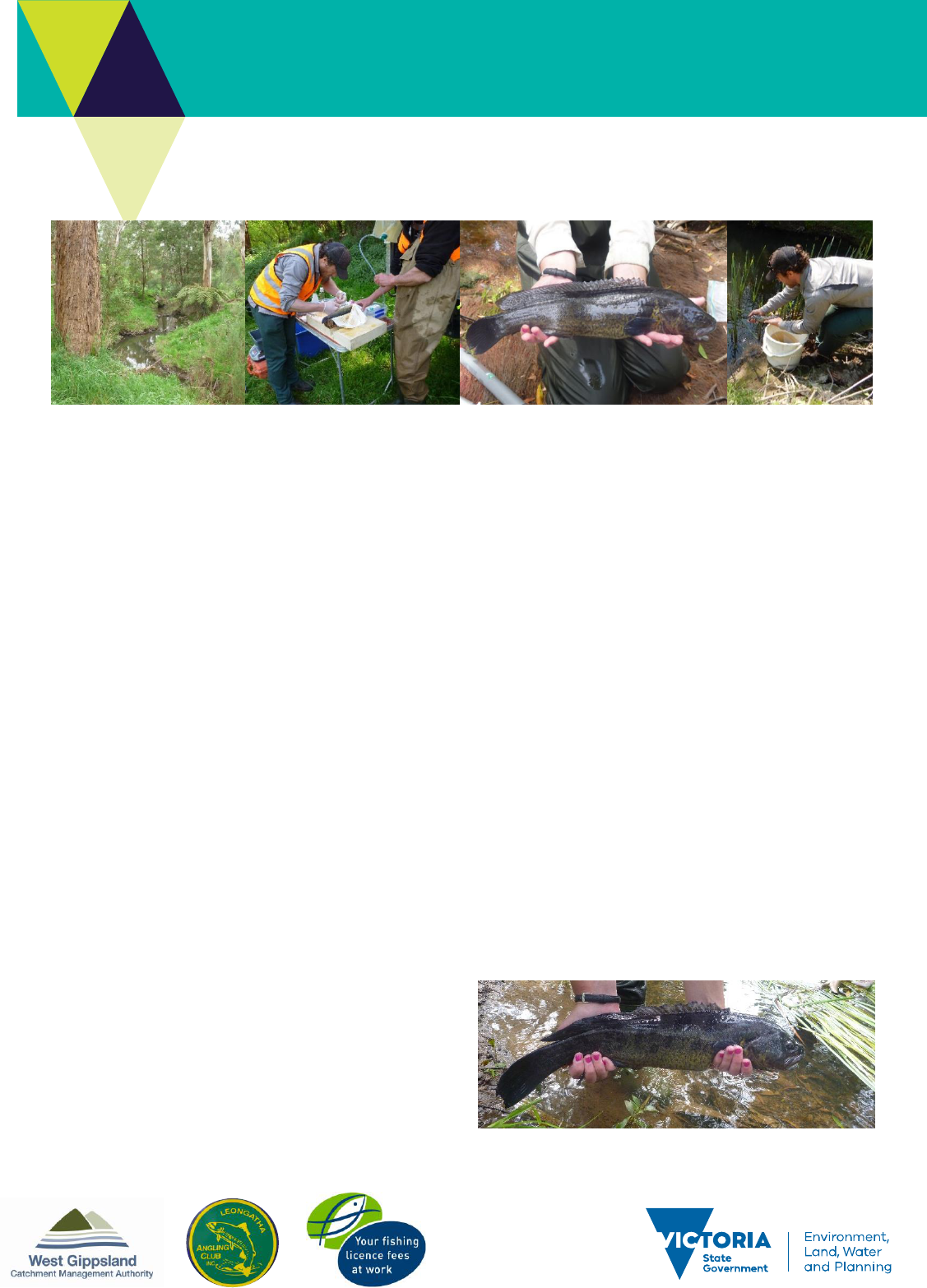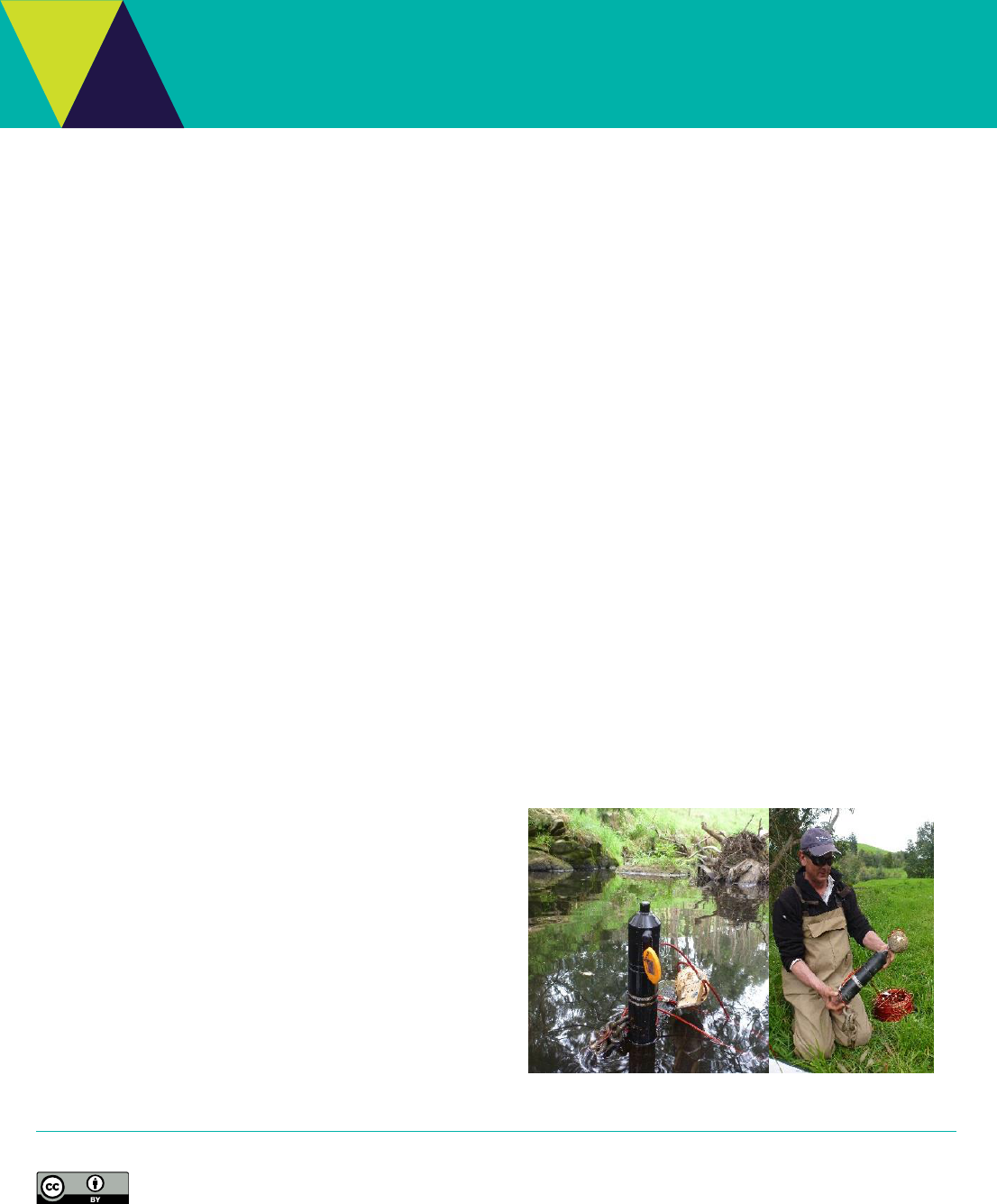
delwp.vic.gov.au
Background
River Blackfish (Gadopsis marmoratus), also known as
Greasys, Slimys and Marbled Cod, are a medium sized
freshwater fish, native to south-eastern Australia. While
River Blackfish live in a range of habitats, adults prefer
pools and woody structures. They typically have a small
home range of about 25-30m, although some fish will
move over 100m. They breed in spring and summer,
when water temperatures are about 14-20°C. Females
lay large, adhesive eggs in hollow logs and cavities of
rocks. Relatively few eggs are laid (generally between
30 – 500 eggs) and larger females produce more eggs.
River Blackfish are a popular angling species and were
historically widespread and abundant, including in west
Gippsland. Leongatha, in the Tarwin River Catchment,
was once one of the best River Blackfish locations in
Victoria. Now, there are fewer in the Tarwin River
catchment and their distribution is patchy (they’re more
often found in upper tributaries). Local anglers note
their catches have steadily declined in recent decades.
Over the last 25 years, West Gippsland Catchment
Management Authority have been working with
landholders and community groups to improve the
health of the Tarwin River catchment and habitat for
River Blackfish and other fish species. Actions include
removing weeds, planting native trees, fencing,
stabilising riverbanks and installing fishways. Since
River Blackfish don’t tend to migrate, and breed locally,
they haven’t however naturally recolonised rehabilitated
areas. Translocating fish into rehabilitated areas may
therefore be a valuable way to support recolonisation
and population recovery in the Tarwin River and other
waterways throughout the species’ range.
Project Objectives
A pilot project commenced in 2015 to:
• translocate River Blackfish into rehabilitated
reaches within their former range in the Tarwin
River catchment.
• assess whether fish remain in the translocated
areas.
• assess if recruitment occurs.
Approach
Twenty-seven adult River Blackfish were collected from
upland areas of the Tarwin River west branch using
backpack electrofishing in October 2015. Fish were
translocated into rehabilitated reaches of Coalition
Creek, a tributary further downstream, where they
previously occurred. To monitor whether River Blackfish
stayed at the translocation sites, fish were tagged with
acoustic transmitters and acoustic receivers were
placed at about 90m intervals along the translocated
reach and at the junction of the Coalition Creek and
Tarwin River. Electrofishing and fyke netting surveys
were subsequently carried out in autumn 2016, 2017
and 2018 to also monitor for fish survival, establishment
of new home ranges, and recruitment.
Fig 1: A River Blackfish ready for release (Photo: ARI)
Translocation of River Blackfish – Tarwin River
pilot study
Project Overview

Translocation of River Blackfish – Tarwin River
pilot study
Results
Acoustic monitoring over the first eight months showed
that twenty-two of the translocated River Blackfish
survived and remained within the translocated reaches.
Five River Blackfish were not recorded after being
translocated. These fish may have not moved past a
receiver, rejected their tags, died or their tags failed.
Of the River Blackfish that were tracked, most fish
moved less than 100m, with two fish moving more than
1km. When stream flows increased, some fish moved
more frequently or over larger distances. One fish even
moved over 1.6 km – the longest distance recorded for
River Blackfish!
A few adult fish and no young fish were collected during
the electrofishing and fyke netting surveys in autumn
2016, while no adult or young fish were collected in
2017 and 2018, suggesting that the River Blackfish
failed to establish permanent, new home ranges and
reproduce. Factors which may explain results include:
• Adult fish stayed in the translocation reaches and
recruited, but adult and juvenile fish have not
been detected in surveys.
• The effect of stress related to translocation close
to the species’ spawning period, resulted in fish
not breeding.
• Not enough fish were translocated to obtain a
viable breeding population.
• Adult fish moved from the site when conditions
become unfavourable.
A severe drought in Coalition Creek about six months
after translocation resulted in the creek ceasing to flow,
with subsequent decreased dissolved oxygen and
increased water temperature. This poor water quality
may have caused translocated fish to leave the
reaches, and reiterates the need to carefully select
translocation sites with good instream and riparian
habitat in catchments not impacted by potential water
quality issues.
Key findings and next steps
This pilot study indicates that River Blackfish can be
translocated and will remain in translocated areas for at
least eight months. Translocation may represent one
tool that can contribute to restoration of River Blackfish
within their former range. Future remediation
approaches should consider using a larger number of
translocated fish and more suitable rehabilitation areas
that are resilient to drought. It would also be worthwhile
investigating the feasibility of a captive breeding and
stocking program for River Blackfish in Victoria.
A Partnership
This work was funded through the Recreational Fishing
Grants Program. West Gippsland CMA managed the
project, ARI undertook the fish research and monitoring,
and the Leongatha Angling Club contributed to site
selection and project support.
Contact
Justin.O’Connor@delwp.vic.gov.au
References
O’Connor, J., Amtstaetter, F., Ayres, R., Koster, W. and
Bowler, M (2016) Translocation of River Blackfish – Tarwin
River pilot study. An unpublished client report for West
Gippsland Catchment Management Authority. ARI
Fig 2: Acoustic receivers placed instream (Photo: ARI)
© The State of Victoria Department of Environment, Land, Water and Planning 2018
This work is licensed under a Creative Commons Attribution 4.0
International licence. You are free to re-use the work under that
licence, on the condition that you credit the State of Victoria as
author. The licence does not apply to any images, photographs or branding, including
the Victorian Coat of Arms, the Victorian Government logo and the Department of
Environment, Land, Water and Planning (DELWP) logo. To view a copy of this licence,
visit http://creativecommons.org/licenses/by/4.0/
ISBN 978-1-76077-105-8 (print), 978-1-76077-106-5 (pdf/online)
Disclaimer
This publication may be of assistance to you but the State of Victoria and its employees
do not guarantee that the publication is without flaw of any kind or is wholly appropriate
for your particular purposes and therefore disclaims all liability for any error, loss or
other consequence which may arise from you relying on any information in this
publication.
Accessibility
If you would like to receive this publication in
an alternative format, please telephone the
DELWP Customer Service Centre on 136186,
email [email protected], or
via the National Relay Service on 133 677
www.relayservice.com.au. This document is
also available on the internet at
www.delwp.vic.gov.au.
